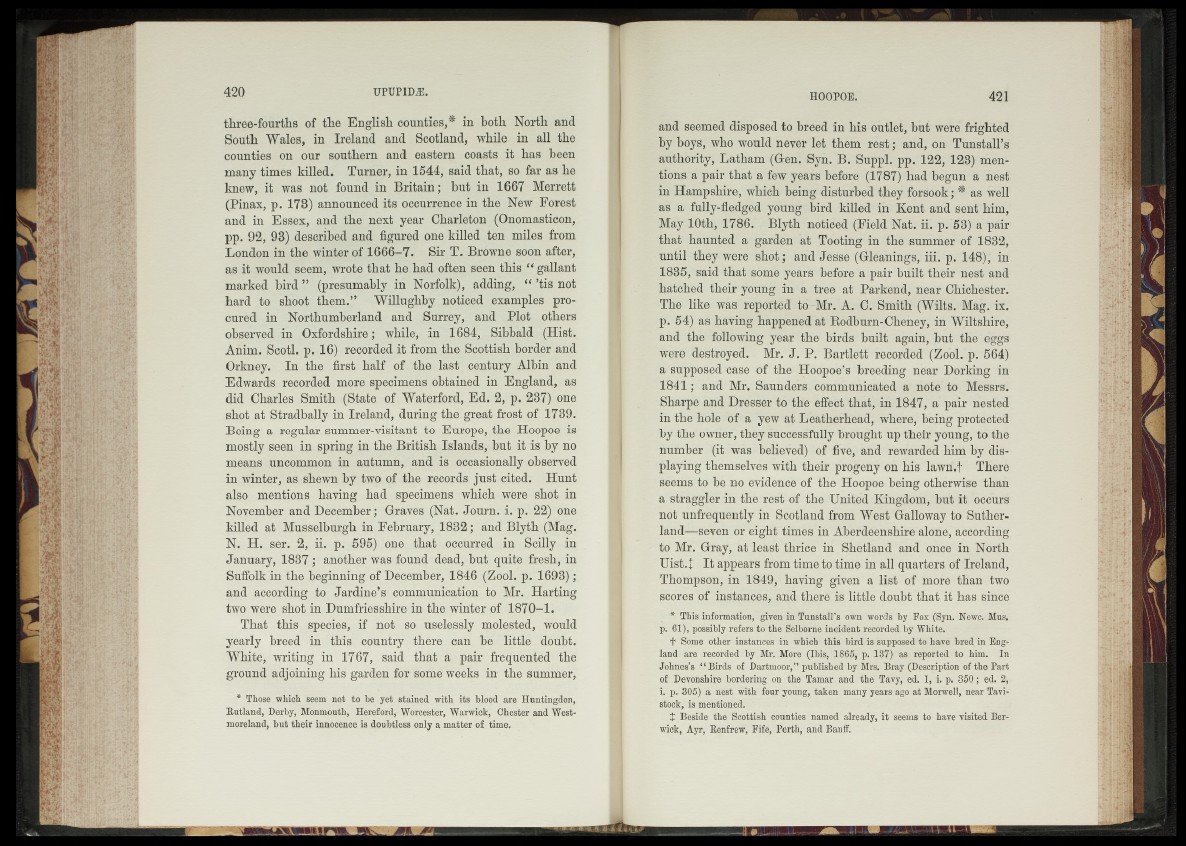
three-fourths of the English counties,* in both North and
South Wales, in Ireland and Scotland, while in all the
counties on our southern and eastern coasts it has been
many times killed. Turner, in 1544, said that, so far as he
knew, it was not found in Britain; but in 1667 Merrett
(Pinax, p. 178) announced its occurrence in the New Forest
and in Essex, and the next year Charleton (Onomasticon,
pp. 92, 93) described and figured one killed ten miles from
London in the winter of 1666-7. Sir T. Browne soon after,
as it would seem, wrote that he had often seen this “ gallant
marked bird ” (presumably in Norfolk), adding, “ ’tis not
hard to shoot them.” Willughby noticed examples procured
in Northumberland and Surrey, and Plot others
observed in Oxfordshire; while, in 1684, Sibbald (Hist.
Anim. Scotl. p. 16) recorded it from the Scottish border and
Orkney. In the first half of the last century Albin and
Edwards recorded more specimens obtained in England, as
did Charles Smith (State of Waterford, Ed. 2, p. 237) one
shot at Stradbally in Ireland, during the great frost of 1739.
Being a regular summer-visitant to Europe, the Hoopoe is
mostly seen in spring in the British Islands, but it is by no
means uncommon in autumn, and is occasionally observed
in winter, as shewn by two of the records just cited. Hunt
also mentions having had specimens which were shot in
November and December; Graves (Nat. Journ. i. p. 22) one
killed at Musselburgh in February, 1832; and Blyth (Mag.
N. H. ser. 2, ii. p. 595) one that occurred in Scilly in
January, 1837; another was found dead, but quite fresh, in
Suffolk in the beginning of December, 1846 (Zool. p. 1693);
and according to Jardine’s communication to Mr. Harting
two were shot in Dumfriesshire in the winter of 1870-1.
That this species, if not so uselessly molested, would
yearly breed in this country there can be little doubt.
White, writing in 1767, said that a pair frequented the
ground adjoining his garden for some weeks in the summer,
* Those which seem not to he yet stained with its blood are Huntingdon,
Rutland, Derby, Monmouth, Hereford,- Worcester, Warwick, Chester and Westmoreland,
but their innocence is doubtless only a matter of time.
and seemed disposed to breed in his outlet, but were frighted
by boys, who would never let them re st; and, on Tunstall’s
authority, Latham (Gen. Syn. B. Suppl. pp. 122, 123) mentions
a pair that a few years before (1787) had begun a nest
in Hampshire, which being disturbed they forsook; * as well
as a fully-fledged young bird killed in Kent and sent him,
May 10th, 1786. Blyth noticed (Field Nat. ii. p. 53) a pair
that haunted a garden at Tooting in the summer of 1832,
until they were shot; and Jesse (Gleanings, iii. p. 148), in
1835, said that some years before a pair built their nest and
hatched their young in a tree at Parkend, near Chichester.
The like was reported to Mr. A. C. Smith (Wilts. Mag. ix.
p. 54) as having happened at Rodburn-Cheney, in Wiltshire,
and the following year the birds built again, but the eggs
were destroyed. Mr. J. P. Bartlett recorded (Zool. p. 564)
a supposed case of the Hoopoe’s breeding near Dorking in
1841; and Mr. Saunders communicated a note to Messrs.
Sharpe and Dresser to the effect that, in 1847, a pair nested
in the hole of a yew at Leatherhead, where, being protected
by the owner, they successfully brought up their young, to the
number (it was believed) of five, and rewarded him by displaying
themselves with their progeny on his lawn.f There
seems to be no evidence of the Hoopoe being otherwise than
a straggler in the rest of the United Kingdom, but it occurs
not unfrequently in Scotland from West Galloway to Sutherland—
seven or eight times in Aberdeenshire alone, according
to Mr. Gray, at least thrice in Shetland and once in North
Uist.t It appears from time to time in all quarters of Ireland,
Thompson, in 1849, having given a list of more than two
scores of instances, and there is little doubt that it has since
* This information, given in Tunstall’s own words by Fox (Syn. Newc. Mus.
p. 61), possibly refers to the Selborne incident recorded by White.
+ Some other instances in which this bird is supposed to have bred in England
are recorded by Mr. More (Ibis, 1865, p. 187) as reported to him. In
Johnes’s “ Birds of Dartmoor,” published by Mrs. Bray (Description of the Part
of Devonshire bordering on the Tamar and the Tavy, ed. 1, i. p. 350; ed. 2,
i. p. 305) a nest with four young, taken many years ago at Morwell, near Tavistock,
is mentioned.
+ Beside the Scottish counties named already, it seems to have visited Berwick,
Ayr, Renfrew, Fife, Perth, and Banff.